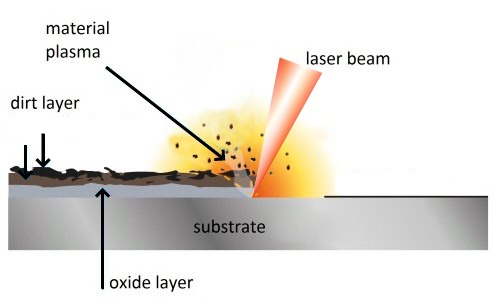HOW DOES LASER CLEANING WORK IN 5 STEPS – Elena
1. All materials have an ablation threshold
Laser ablation occurs when a layer of a material or a material which is deposited on a given surface is removed with the aid of a laser beam. This is actually the process behind laser rust removal on steel and other materials. Molecular bonds in the dust or rust layer are broken and ejected from the substrate. In less technical terms, you can imagine that the layer to be removed is simply vaporized by the laser beam.

fig. 1 – Laser Ablation
A simple way to get a grasp of the importance of the laser threshold is to relate the concept of the laser threshold to one of throwing a ball over a wall. If you don’t throw the ball higher than the wall, it will obviously never make it over. Even if you repeat throwing the ball a thousand times, the ball will always fail to make it to the other side. It’s the same thing with laser derusting. You can shoot the laser beam a thousand times and as long as the energy is below the threshold necessary to impact the particular material you are working with, everything will remain the same.
Now, since every material has different properties and thus different molecular bonds; there is a specific ablation threshold for each material. Therefore, to successfully remove a layer from a given material. It is important to make sure above the ablation threshold of that particular material, can transferre the energy by the laser beam.
2. It is possible to remove a material in a highly selective way
Let’s continue with our analogy. Imagine there was a second, higher wall behind the first and throw a ball with just enough energy to make it over the first wall. But the ball does not have enough energy to make it over the second wall. It will then bounce off the second wall and fall in between the two walls. Once again, no matter how many times you throw the ball, you will always get the same result. You will make it past the first wall, but not the second.
Since there is an ablation threshold for each material. It is possible to discriminate between two or more materials when trying to remove an undesired layer from an object. Given a sufficiently large ablation threshold difference between the materials. It is possible to select one material and removed it (the one with the lower ablation threshold), leaving the other material untouched.
For example, the rust ablation threshold is much lower than the threshold for common metals such as aluminum or steel. The same goes for paint and oil thresholds compared to the thresholds for different metals. It is this vast gap between the two values that effectively allows rust to be completely vaporized without any risk of damage to the steel underneath. There’s just not enough energy for damage to happen.

